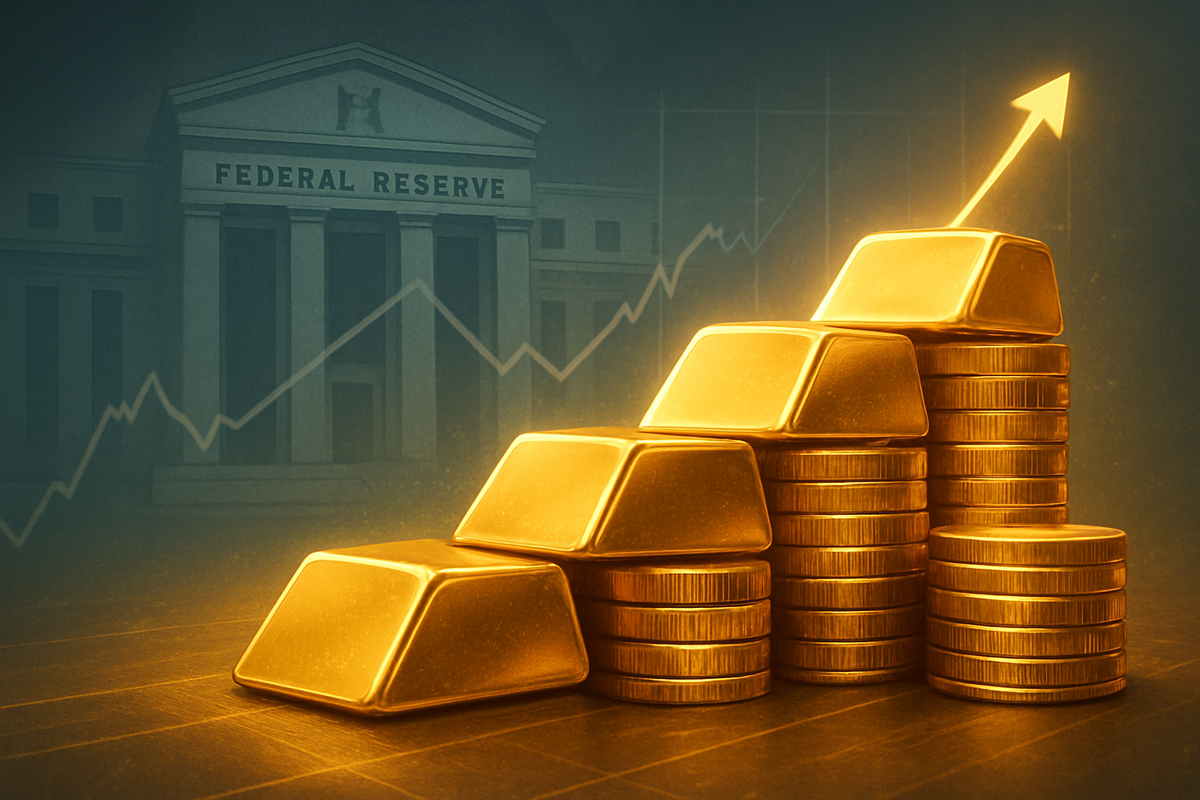
New York, NY – November 13, 2025 – The global financial markets are buzzing with activity as gold prices are not merely holding steady, but rather surging, reaching multi-week highs and demonstrating significant year-over-year gains. This robust upward momentum in the precious metals market is overwhelmingly driven by intense investor anticipation of an imminent Federal Reserve monetary policy decision, with expectations firmly set on interest rate cuts. This dovish outlook from the U.S. central bank is profoundly influencing market dynamics, fostering a strong bullish sentiment for gold and other precious metals.
The current rally underscores gold's enduring appeal as a safe-haven asset amidst a backdrop of global economic uncertainties and a weakening U.S. dollar. Investors are actively re-positioning their portfolios, shifting capital into non-yielding assets like gold, as the opportunity cost of holding such assets diminishes with the prospect of lower interest rates. The stage is set for a potentially pivotal moment in monetary policy, with profound implications for asset valuations across the board.
The Golden Rush: Dissecting the Surge and the Fed's Shadow
Gold's recent performance has been nothing short of spectacular. As of November 13, 2025, spot gold has been trading robustly, hovering between approximately $4,207.48 and $4,231.19 per ounce. This marks a notable gain of 0.29% from the previous day, a 1.55% increase over the past month, and an astounding 63.92% rise compared to the same period last year. The precious metal even touched an all-time high of $4,381.58 or $4,530.00 per ounce in October 2025, according to various reports, before entering a brief consolidation phase. However, the underlying trend remains strongly bullish, propelling gold into a new era of elevated valuations.
The timeline leading up to this moment has been characterized by a confluence of economic signals and policy anticipations. Following its October peak, gold experienced a period of consolidation, trading within the boundaries of $3,900 support and $4,400 resistance. However, a renewed wave of optimism, fueled by increasingly clear signals from the Federal Reserve, has ignited the latest rally. Key players in this unfolding drama include the Federal Reserve's Federal Open Market Committee (FOMC), individual Fed governors like Stephen Miran who has openly suggested larger rate cuts, and a vast cohort of global investors, central banks, and gold-backed Exchange Traded Funds (ETFs).
Investor sentiment is overwhelmingly focused on the Federal Reserve's upcoming monetary policy decision, with strong expectations for an interest rate cut in December. Traders are currently assigning a high probability, estimated between 63% and 68%, to a 25-basis-point reduction at the next FOMC meeting. These expectations are not unfounded; they stem from a series of indicators pointing to a softening U.S. economy. Weak U.S. job data, including job losses in October—particularly in government and retail sectors—and a significant decline in consumer sentiment to a 3½-year low in early November, have all fueled the calls for monetary easing. Furthermore, the longest-ever U.S. government shutdown, which recently concluded, delayed the release of crucial economic data, forcing investors and policymakers to rely on private reports that consistently signal labor market weakness, thereby reinforcing the likelihood of further rate cuts.
Adding to the anticipation are signals that the Fed is preparing for "ample" liquidity bond buying, indicating a pivot away from quantitative tightening (QT) towards a new cycle of monetary expansion, often perceived as "stealth quantitative easing." This strategic shift aims to bolster the financial system's reserves and is interpreted by markets as a decisive move towards a more accommodative policy stance. The immediate market reactions have been predominantly bullish, characterized by increased investor inflows into gold-backed ETFs and continued accumulation by central banks globally, all contributing to the precious metal's upward trajectory.
Winners and Losers: Corporate Implications of a Golden Surge
The surging gold prices, driven by the anticipated Federal Reserve rate cuts, create a distinct landscape of winners and losers within the financial markets, particularly impacting companies involved in the precious metals sector.
Potential Winners:
- Gold Mining Companies: These are the most direct beneficiaries. Companies like Barrick Gold (NYSE: GOLD), Newmont Corporation (NYSE: NEM), and Agnico Eagle Mines Limited (NYSE: AEM) stand to see significant increases in their revenue and profitability as the price of their primary product rises. Higher gold prices directly translate to fatter margins, assuming production costs remain relatively stable. This could lead to increased exploration budgets, dividend payouts, and share buybacks.
- Precious Metals Streamers and Royalty Companies: Firms such as Franco-Nevada Corporation (NYSE: FNV) and Wheaton Precious Metals Corp. (NYSE: WPM), which provide upfront financing to miners in exchange for a percentage of future production or revenue, will also see their assets appreciate in value. Their business model inherently leverages rising commodity prices with minimal operational risk.
- Gold-Backed Exchange Traded Funds (ETFs): Funds like SPDR Gold Shares (NYSE Arca: GLD) and iShares Gold Trust (NYSE Arca: IAU) will experience increased demand and asset under management (AUM) as investors flock to gold. This translates to higher management fees for the fund providers.
- Jewelry Retailers with Existing Inventory: Retailers holding significant gold jewelry inventory purchased at lower prices could see an increase in the value of their stock. However, this is a nuanced benefit, as higher gold prices can also deter consumer demand for new purchases.
Potential Losers (or those facing headwinds):
- Companies Highly Sensitive to Inflation (if rate cuts fail to curb it): While gold is often an inflation hedge, if the Fed's easing leads to runaway inflation that outpaces economic growth, some sectors might struggle with rising input costs that cannot be passed on to consumers.
- Companies Reliant on a Strong Dollar: A weaker U.S. dollar, a likely consequence of rate cuts, could negatively impact U.S. companies that import goods or have significant international operations where their revenues are converted back into a less valuable dollar.
- Short Sellers of Gold: Those who have bet against gold prices will face significant losses as the value of the metal climbs.
The overall impact on these companies will depend on the magnitude and duration of the gold price surge, as well as the specific operational leverage and hedging strategies employed by individual firms. However, for the gold mining sector and related entities, the current market environment presents a significant tailwind.
Beyond the Glitter: Wider Significance and Historical Context
The current surge in gold prices and the underlying anticipation of Federal Reserve rate cuts represent more than just a fleeting market event; they signify a broader shift in economic sentiment and monetary policy. This event fits squarely into the broader industry trend of investors seeking safe-haven assets amidst persistent global economic uncertainties, geopolitical tensions, and concerns regarding U.S. fiscal health. Gold's traditional role as a hedge against inflation and currency debasement becomes particularly pronounced during periods of monetary easing and economic deceleration.
The potential ripple effects extend beyond gold to other precious metals. Silver prices, for instance, have also surged, in some instances reaching $53 per ounce, demonstrating a correlated response to the same macroeconomic drivers. This indicates a broader bullish trend across the precious metals complex. The Fed's anticipated pivot from quantitative tightening (QT) to potential "stealth quantitative easing" carries significant regulatory and policy implications. It signals a renewed commitment to providing ample liquidity to the financial system, potentially impacting bond markets, currency valuations, and the overall cost of capital. This shift could set a precedent for future monetary policy responses to economic downturns, emphasizing liquidity provision over direct stimulus.
Historically, periods of Federal Reserve easing have often coincided with strong performance in the gold market. When interest rates are cut, the opportunity cost of holding non-yielding assets like gold decreases, making it more attractive relative to interest-bearing investments. For example, during the aftermath of the 2008 financial crisis and subsequent periods of quantitative easing, gold experienced a multi-year bull run. Similarly, during periods of economic uncertainty in the early 2000s, gold saw significant appreciation as the Fed lowered rates. This historical precedent lends credence to the current market's bullish outlook, suggesting that the present surge is not an anomaly but rather a predictable response to anticipated monetary policy shifts.
The Road Ahead: Navigating the Golden Future
The immediate future for gold prices hinges critically on the Federal Reserve's upcoming monetary policy decision. In the short term, if the Fed delivers the anticipated 25-basis-point rate cut, or even a larger 50-basis-point cut as some, including Fed Governor Stephen Miran, have suggested, gold is likely to sustain its upward momentum. A decisive move by the Fed would reinforce investor confidence in a dovish stance, further diminishing the opportunity cost of holding gold and potentially weakening the U.S. dollar, both strong tailwinds for the precious metal. Conversely, a surprise decision to hold rates steady, though less probable given current market expectations, could trigger a temporary correction in gold prices as investors re-evaluate their positions.
In the long term, the trajectory of gold will be influenced by the broader economic recovery, inflation outlook, and the continued geopolitical landscape. If the Fed's easing successfully stimulates economic growth without triggering runaway inflation, gold's safe-haven appeal might temper slightly. However, if inflation concerns persist or global uncertainties deepen, gold's role as a store of value and hedge will remain paramount. Potential strategic pivots for investors and corporations include diversifying portfolios to include more precious metals, and for mining companies, accelerating development projects to capitalize on higher prices.
Market opportunities may emerge for investors looking to "buy the dip" if any short-term consolidations occur after the initial rally. Challenges could include increased volatility around major economic data releases and central bank announcements. Potential scenarios range from a sustained bull market for gold, pushing prices towards the $4,500-$5,000+ range projected by institutions like Goldman Sachs (NYSE: GS) and JPMorgan Chase & Co. (NYSE: JPM) by 2026, to more moderate gains if economic conditions stabilize faster than expected. Investors should closely monitor the Fed's communication, inflation data, and global risk factors to adapt their strategies accordingly.
The Enduring Allure: A Comprehensive Wrap-Up
In summary, the current financial landscape is witnessing a significant surge in gold prices, driven primarily by strong investor anticipation of Federal Reserve interest rate cuts. This is not a period of stability but rather one of robust growth, with gold reaching multi-week highs and demonstrating substantial year-over-year gains. Key takeaways include the diminishing opportunity cost of holding gold, a weakening U.S. dollar, and heightened safe-haven demand amidst global economic uncertainties. The market is clearly signaling its expectation for a more accommodative monetary policy from the Fed, moving away from quantitative tightening towards liquidity provision.
Moving forward, the precious metals market is poised for continued dynamism. While short-term consolidations are possible, the overarching sentiment for gold remains strongly bullish. The Fed's upcoming decision will be a critical determinant of gold's immediate trajectory, but the longer-term outlook appears bright, supported by historical precedents and ongoing macroeconomic factors. Investors should remain vigilant, paying close attention to the Federal Reserve's pronouncements, inflation indicators, and geopolitical developments. The enduring significance of this event lies in its potential to usher in a new cycle of monetary easing, reinforcing gold's timeless role as a critical component of diversified investment portfolios and a reliable hedge against economic instability. The coming months will undoubtedly offer compelling insights into the interplay between monetary policy and commodity markets.
This content is intended for informational purposes only and is not financial advice





